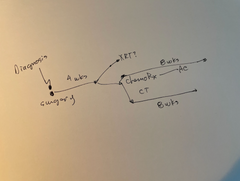When I first learned I needed breast surgery as part of my cancer treatment, I had so many questions running through my mind. Among them was a seemingly simple one: "What will I wear after the surgery?" That's when my surgeon introduced me to compression bras, and honestly, it became a super important recovery tool. Whether you're preparing for a mastectomy like I had, or having breast reconstruction, augmentation, or other breast surgeries, wearing a compression bra is a crucial part of your healing.
I want to share what I've learned about compression bras – from what they are to why they're so important – to help you feel more prepared and confident about your recovery process.
Want more information about reconstruction? Or breast cancer treatments? Click here to learn more about Your Interactive Cancer Maps, our step-by-step guide to help you navigate the cancer experience from diagnosis to living with “the new normal” after treatment. Learn more here.
What is a Compression Bra?
A compression bra isn't like your everyday bra. Think of it as a medical garment specially designed to help you heal after surgery. When I first saw mine, I noticed it looked more like a sports bra but with some key differences. It's made from firm, stretchy material that applies gentle pressure all around your chest. Most have front closures (which are a lifesaver when your arms are sore), and they don't have underwires or fancy lace – they're all about function and comfort.
Why might I need to wear a Post-op bra/post surgery bra?
What does a compression bra do? I remember asking this same question to my surgeon. Here's what I learned about why these special bras are so important:
- They keep everything in place while you heal
- They protect your surgical sites from unnecessary movement
- They help your body adjust to its new shape
- They reduce the risk of complications
- They can make you feel more secure and supported during recovery
Benefits of Wearing a Compression Bra After Surgery/Mastectomy
1. Reduces Swelling
This was one of the first benefits I noticed after my surgery. The gentle, constant pressure from the compression bra helped keep swelling down. Think of it like giving your chest a gentle, continuous hug. My surgeon explained that this pressure helps control fluid buildup, which not only makes you more comfortable but also helps your body heal better.
2. Promotes Healing and Reduces Scarring
I was amazed to learn how compression actually helps with healing. The steady pressure improves blood flow to the surgical area, which brings more oxygen and healing nutrients to your tissue. It also helps your scars heal better – something I was particularly concerned about.
3. Provides Comfortable Support and Reduces Pain
Let me tell you – the right compression bra becomes your best friend during recovery. When I tried to go without it for even a short time (which my doctor advised against), I really felt the difference. The support helps reduce pain and that pulling sensation around your surgical sites. It's especially helpful when you're trying to sleep or moving around.
4. Minimizes Risk of Post-Op Complications
This is super important. Proper compression helps prevent several possible complications, like fluid collection (called seroma) or excessive swelling. My medical team explained that wearing the bra as directed was one of the best things I could do to ensure a smooth recovery.
Types of Compression Bras for Post-Surgery Recovery
Front-Closure Bras
These were my favorite! Trust me – after breast surgery, you don't want to be twisting around trying to hook a bra behind your back. Front-closure bras make it so much easier to put on and take off, especially in those first few weeks when your range of motion is limited.
Adjustable Compression Bras
Swelling changes a lot during recovery, so having a bra that can adjust with you is really helpful. These bras usually have multiple hook settings or adjustable straps to help you maintain the right amount of pressure as your swelling goes down.
High-Impact and Supportive Bras
These come in handy later in your recovery when you're starting to be more active. They provide extra support while still maintaining the compression you need.
How Do Compression Garments Work?
Let me explain this in simple terms, just like my doctor explained it to me. Compression garments work by applying steady pressure to your surgical area. This pressure helps:
- Push extra fluid out of the area (like squeezing a sponge)
- Keep blood flowing properly
- Hold everything in the right position while you heal
- Reduce movement that could stress your healing tissues
It's like having a constant, gentle support system for your body while it does the hard work of healing.
How to Choose the Right Compression Bra
Consider Material and Comfort
Look for soft, breathable fabrics that won't irritate your skin. I found that cotton-blend materials worked best for me. Avoid anything with scratchy seams or tags. Remember, you'll be wearing this a lot, so comfort is key!
Proper Fit and Support
Getting the right fit is super important. Your bra should be snug but not tight enough to leave marks or make breathing difficult. I recommend trying different sizes if possible, and remember that your size might change as swelling goes down.
Guidance from Your Surgeon
Always follow your surgeon's specific recommendations. They might have particular brands or styles they prefer based on your type of surgery. Don't be shy about asking questions – I certainly wasn't!
How Long Should You Wear a Compression Bra?
This is one of the most common questions, and the answer varies depending on your surgery. In my case, I needed to wear it 24/7 for the first six weeks, except when showering. Then I gradually transitioned to no bra (totally my choice, some women look for other bras to wear during this time) over the next few weeks.
Your surgeon will give you specific guidelines, but typically you can expect:
- 4-8 weeks of continuous wear
- Gradual transition to regular bras (or no bra if you’re like me!)
- Possibly longer wear times for exercise or strenuous activities
Myths and Misconceptions about Compression Garments
Let me clear up some things I initially worried about:
- Myth: Compression bras are unbearably uncomfortable
- Truth: While they're snug, a properly fitted one shouldn't hurt
- Myth: You only need them for a few days
- Truth: They're important for several weeks of healing
- Myth: Any tight sports bra will do
- Truth: Medical-grade compression bras are specially designed for post-surgery healing
- Myth: They're only necessary for major surgeries
- Truth: They help with recovery from most breast procedures
Cancer Maps to help you find your way, one decision at a time.Built for Patients, by Patients. Backed by World-Leading Oncologists

Tips for Wearing Your Compression Garment Comfortably
Here are some tips I learned along the way:
- Have at least two bras so you can wash one while wearing the other
- Use soft cotton pads under the bra where it touches incision sites
- Adjust straps and bands throughout the day as needed
- Keep your skin clean and dry under the bra
- Follow washing instructions carefully to maintain the bra's compression
- Listen to your body – if something doesn't feel right, tell your doctor
Conclusion
Looking back on my breast surgery experience, I can say that my compression bra played a huge role in my recovery. Yes, it took some getting used to, and yes, there were days when I wished I could just wear my old comfortable bras. But the benefits far outweighed any temporary discomfort. Remember, wearing a compression bra is an investment in your healing process. Follow your doctor's guidelines, be patient with yourself, and know that each day brings you closer to recovery.
Also Read:
- Why Do Women Lose Breast Sensation After Mastectomy?
- Updated Mammogram Screening Guidelines for Preventative Breast Cancer Screening
- Life After Early Stage Breast Cancer: What To Expect 5 and 10 Years After Treatment
- Best Reconstruction Options after Mastectomy
- Life After Early Stage Breast Cancer: Your Survivorship Care Plan
- Tips for Finding Balance After Early Stage Breast Cancer
Take charge with free, expert-crafted resources from Manta Cares—designed to support and empower cancer patients and their caregivers every step of the way. Explore now!
-
FREE Chemotherapy Checklist for Caregivers
- FREE Quick Start Guide to a Cancer Diagnosis
- FREE Gift-Giving Guide
- FREE Caregiver Communication Guide
- Life Wheel Audit: A simple exercise to re-center, re-prioritize and re-start new habits
- Eating the rainbow. Free shopping guide
- Free Financial Checklist for Cancer Treatment
- FREE Reflection Exercise
FAQs on Why a Compression Bra is Essential After Breast Surgery
Q: Why is it necessary to wear a compression bra after breast surgery?
Ans - It helps control swelling, supports healing tissues, reduces pain, and helps prevent complications during recovery.
Q: Do I really need a post-op bra after breast surgery?
Ans - Yes! It's not just helpful – it's an essential part of your recovery process that helps ensure the best possible results.
Q: Are compression garments painful?
Ans - When fitted properly, they shouldn't be painful. They'll feel snug but not uncomfortable. If you're experiencing pain, talk to your doctor about adjusting the fit.
Q: What are the main benefits of wearing a compression bra post-surgery?
Ans - The main benefits include reduced swelling, better healing, less pain, and lower risk of complications.
Q: Are there different types of compression bras for various breast surgeries?
Ans - Yes, different surgeries might require different levels of compression or specific features. Your surgeon will recommend the right type for your procedure.
Q: How do I clean my compression garment?
Ans - Usually with gentle hand washing in cool water with mild soap. Always check the care instructions and have a backup bra to wear while one is being cleaned.
Q: Can I sleep in my compression bra after surgery?
Ans - Yes, most surgeons recommend wearing it 24/7 during the initial recovery period, including while sleeping.
Q: Can I wear a compression bra during exercise after breast surgery?
Ans - Once your doctor clears you for exercise, yes! In fact, it's especially important to wear proper compression during physical activity.
Join a community of people who “get it”
The Manta Cares team is composed of cancer survivors, caregivers, oncologists and nurses - so we truly understand the challenges that come with a cancer diagnosis because we’ve been there. We are here to walk with you as you go through your own cancer experience. Please don’t hesitate to reach out with any questions. We have even developed Your Interactive Cancer Maps, a platform with disease-specific step-by-step maps to show you all the paths you might face during your cancer experience, future treatment options and connect you with relevant support and resources. Sign up for access to the Your Interactive Cancer Maps platform here.
Be sure to subscribe to our newsletter and check out our free resources like our Chemotherapy Checklist for Caregivers, Financial Checklist for Cancer Treatment and more. We also put out a bi-weekly podcast called the Patient from Hell to educate, empower and hopefully inspire you as you go through this crappy experience. You can listen on Spotify, Apple Podcasts, YouTube or anywhere you listen to podcasts. Dealing with cancer as a patient or caregiver can feel really lonely. Just know that you are not alone in this experience.
Disclaimer: All content and information provided in connection with Manta Cares is solely intended for informational and educational purposes only. This content and information is not intended to be a substitute for medical advice, diagnosis, or treatment. Always seek the advice of your physician or other qualified health provider with any questions you may have regarding a medical condition.





